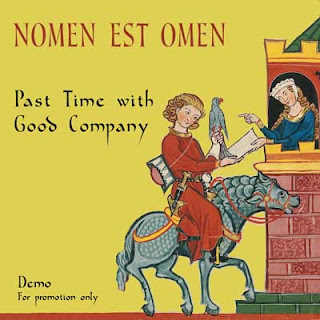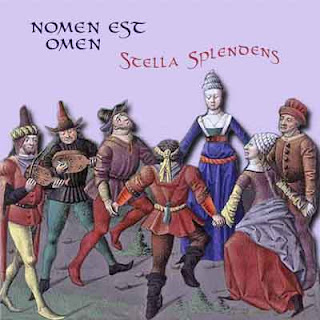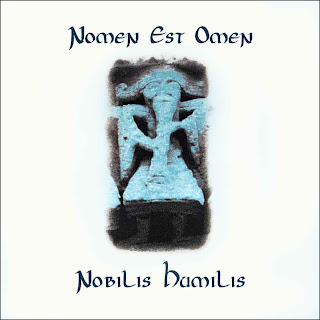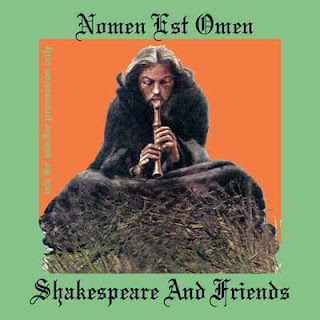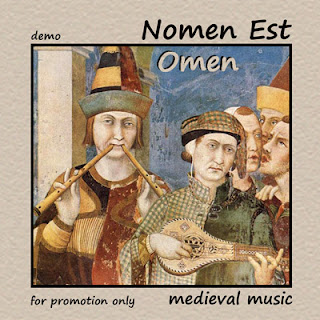In 2009, Nomen Est Omen has set up a home studio and went to the stage of self recording. From January to March 2010 records for the album Past Time With Good Company were made, concentrating on wind instruments (to which were added guitar and percussion) and postprocessing was done until August, at which time the album was released in the Medieval Festival Transylvanian Citadels of Sibiu. The version putted into circulation was not the final one, but an intermediate unmastered by professionals. Nomen studio kit consists of devices dedicated to recording, but sound engineering involves a different specialization than that of singing. Past Time With Good Company 2010 is for now a calibrated and panoramic version of an album that will see a significantly better technically edit in the future.
Apr 7, 2013
Past Time With Good Company 2010
Posted by
Nomen Est Omen
|
11:40 AM
|
Medieval Festival
,
Nomen Est Omen
,
Past Time with Good Company
,
Sibiu
,
Transylvanian Citadels
1600 (compilation + bonus tracks) 2007
Posted by
Nomen Est Omen
|
11:33 AM
|
1600
,
album
,
D'Un Chateau L'Autre
,
Fabritio Caroso
,
From the Castle to Another
,
John Dowland
,
Nomen Est Omen
,
Robert Johnson
,
Shakespeare and Friends
,
Witchcraze
The album 1600 was built around five songs that were recorded for Witchcraze and not entered in the final CD, because they had not found the right place in relation to other pieces. These are two compositions by John Dowland, one of Fabritio Caroso and two dances composed by anonymous authors. Besides these, on 1600 have entered a previously recorded suite by Robert Johnson in 1998 for the concert album From the Castle to Another and then in the same year in the studio for D'Un Chateau L'Autre (eventually published in Shakespeare & Friends), and seven studio tracks appeared on previous albums, plus a live piece. The album is unified, despite the fact that the material belongs to several recording sessions and are conducted over time in different studios. The compositions are from year 1600, as shown by the elliptical title chosen for the album. The material, gathered under one name, aims to integrate in a consistent CD some parts already completed, but also to mark the collaboration with several musicians who had passed through the band without having appeared on any album.
Stella Splendens 2005
Posted by
Nomen Est Omen
|
11:26 AM
|
album
,
Brauner VM 1S
,
Bucharest
,
George Patranoiu
,
Hunedoara
,
Hunyad Castle
,
Nomen Est Omen
,
Sighisoara
,
Stella Splendens
,
Witchcraze
Stella Splendens is another album already out in conditions typical of Nomen Est Omen, namely a project carried out within five days, between two tours. The Ensemble performed some concerts extremely well received by the public in the Hunyad Castle from Hunedoara, many people asking, later inquiring about albums. Being the first contract in that city, for a first edition of the festival, stage appearance was not accompanied by the usual media campaign or stand for compact discs. Public interest has led to the idea of multiplying a new batch of albums Witchcraze for next weekend's festival, where Nomen Est Omen was to perform several concerts. Returned to Bucharest in a Monday just to leave next Thursday (evening) to Mures, Nomen Est Omen members have decided to remain in the studio and started to record another album, with songs from the tours repertoire because three years had elapsed from the previous one, anyway into circulation from some time ago in Targu Mures and Sighisoara. For the new project was contacted old friend and collaborator, George Pătrănoiu, that did the postprocessing of the first Nomen Est Omen nine years before. Recordings were made over three days and nights in July 2005, a period of hot weather with temperatures above 40 degrees in the shade. A fourth day was intended for mastering, making the covers and multiplication of the first few hundred copies. The album was put on circulation the following days, at the famous medieval art festival in Sighisoara, again freely distributed. The contracts signed in the near future, some indirect result of the album Stella Splendens, have covered the costs of production. A notable event of this discographic step was that just before recording the first seconds of music, the lamp of a microphone burned, without any logical explanation to be found then or later. Microphone, a Brauner VM 1S, perfectly in function when tested before, could not be repaired anymore.
1484. Summis Desiderantes Affectibus. Witchcraze 2002
Posted by
Nomen Est Omen
|
11:19 AM
|
Adrian Motoc
,
Bucharest
,
Club A
,
Dracula
,
extreme rock
,
Iasi
,
Ioan Cora
,
Mihai Plamadeala
,
Nomen Est Omen
,
Park
,
TV
,
Witchcraze
The seventh year of existence of Nomen Est Omen with seven albums made so far, more or less official, but entered in the romanian genre's public attention, was very special. The album 1484. Summis Desiderantes Affectibus. Witchcraze, shortly known as Witchcraze, came amid a re-branding campaign undertaken by the band, which began to focus on the anthropological component of the music interpreted and introduced adjacent educational activities in its projects. The story of the album begins on January 1, 2002, when Nomen Est Omen and Cora Consulting, through Ioan Cora and Mihai Plămădeală, made an agreement for sponsorship in order to produce the album. There followed a period of several months of work and documentation for selecting repertoire and making musical arrangements. A studio from Iasi (where prices are lower than in Bucharest) was luckely selected and Nomen Est Omen had the opportunity to work with a valuable engineer, Adrian Motoc. The recordings were made in seven days and the post-processing in three, in May. This is the first album hi fi, published on CD, whose rights belong to the group. Nomen Est Omen wanted to release the album at the festival from Sighisoara, but objective factors have prevented this. The area of the beautiful medieval town, in fact protected by international organizations, came to the attention of economic interest groups who wanted to exploit its tourism irrationally. During the campaign to support construction of an aberrant Dracula Park, the festival was hijacked, and dance and extreme rock bands were brought. It was the most embarrassing moment in the history of the event. With the support of Romanian Television (TVR), Nomen Est Omen originally intended to launch the album in Sighisoara, in parallel with the official festival, but the project eventually became an animadversion documentary on the organizers. The official launch took place in Bucharest in November, in Club A and benefited from a 40-minute show broadcasted by TVR. From the album's biography should be noted that the first batch of CD products (complete with cover and screen printing) was lost, the expenses being supported by the person responsible. Finally, anything that can be heard on Witchcraze is not related to magic. In parallel with the ignition pyres in Europe, people continued their lives normally, by following the activities and also entertaining course. Therefore it is about the music of the period reported to the "witchcraze", not about a form of ritual expression. This is the premise of the album.
Nobilis Humilis (studio concert) 2001
Posted by
Nomen Est Omen
|
11:09 AM
|
album
,
Ciprian Porumbescu
,
concert
,
Conservatory
,
Medieval Art Festival
,
Nomen Est Omen
,
Sighisoara
,
studio
,
tape
,
underground
In 2001, Nomen Est Omen signed a contract for six concerts in the Medieval Art Festival of Sighisoara - an ideal opportunity to launch a new album. Membership of the band's previous album was partially different from that of the time, recordings were made in principle under the expectations and, if appropriate processed materials, copyrights were pending. In these circumstances, Nomen Est Omen opted for fast recording of a studio album made entirely in four hours, a few days before the festival, until the beginning which were multiplied five hundred copies (tapes). Underground aspect that characterized the band so far, has been preserved this time too: order for the studio being insignificant, the project materialized courtesy of sound engineer (friend and former colleague at the Conservatory "Ciprian Porumbescu" with one of the Nomen Est Omen members) without money, receipt and owner's knowledge, after hours, ie at night. The album, without taxes payed (and legal rights to sell it) was distributed free, the expenses being covered by donations.
Shakespeare & Friends 2000
Posted by
Nomen Est Omen
|
10:54 AM
|
D'Un Chateau L'Autre
,
George Frideric Handel
,
Grave Muller Consort
,
Mihai Plamadeala
,
Nomen Est Omen
,
Omina Prima
,
Robert Johnson
,
Shakespeare and Friends
,
The Tempest
,
William Shakespeare
After the (thematic) inclusion of two thirds of the project D'Un Chateau L'Autre in the promotional album Omina Prima in 1999, the next year was dedicated by Nomen Est Omen to the integration of the (remaining) eight songs in a album that would highlight them properly. These are the dances and the ballets of Robert Johnson (c. 1583 – c. 1634), composed for the play of William Shakespeare, The Tempest. The resulting album, like the previous two, is one not for sale, for promotion only. The idea of his name, Shakespeare & Friends, was inspired by a concert held by Grave Muller Consort in Göteborg, where Mihai Plămădeală attended; that concert repertoire consisted of compositions by George Frideric Handel and some of his contemporaries. On the album Shakespeare & Friends, along with the mentioned suite of Robert Johnson were included works from the Elizabethan period in circulation during the life of “the Bard of Avon” and that he possibly, even likely, might have heard it. The additional songs are from Nomen Est Omen’s concerts.
Apr 6, 2013
Omina Prima 1999
Posted by
Nomen Est Omen
|
10:33 PM
|
broadcasts
,
D'Un Chateau L'Autre
,
Doru Ionescu
,
Mihai Plamadeala
,
Nomen Est Omen
,
Omina Prima
,
Remix
,
Timpul Chitarelor Electrice
,
TV
A number of changes in the relation between parties led to the fact that at the ending of the post-processing and mastering of the 60 minutes album, D'Un Chateau L'Autre, the interests of the studio, as a service provider, of the talent agency who assumed the obligations (and rights) as a producer and of the band did not coincide anymore. The legal status of the sound material recorded by Nomen Est Omen in the fall of 1998 remained uncertain, a fact amplified at one moment by the declaration of the loss of the project from the database. The subsequent transaction of the devices on which the album was recorded, together with the studio and the company, seemed to seal forever the loss of the tracks, in fact the work of the studio and performers. However, materials occurred at a time, in a decent stereo version, much better in quality than the mono version which was previously in circulation. TV producer Doru Ionescu (Remix, Timpul chitarelor electrice) who made a series of interviews, broadcasts and a clip of the band, came into possesion of the post-processed material and returned it to Mihai Plămădeală. Without the legal or ethical rights to officially release the album, Nomen Est Omen, in a partially changed formula, used the files only as a demo, making at the same time a thematical division, as it was planned at the beginning of the recordings for the two CDs. Therefore, the album Omina Prima received a title, forty minutes of music, a cover and benefited from a logical playlist in 1999. It is the first material of Nomen Est Omen that gets out of the lo fi sign, but remains in underground. The main desire of the band was that, in the absence of gains arising from copyright, at least the performers to be recognized.
D'Un Chateau L'Autre (compilation) 1998
Posted by
Nomen Est Omen
|
10:23 PM
|
D’Un Chateau L’Autre
,
Elizabethan music
,
Fratostiteanu
,
Iasi
,
medieval
,
Nomen Est Omen
,
Paul Barzu
,
Plamadeala
,
Titan
,
Zebra Sound
D’Un Chateau L’Autre, the third attempt to make an album in Iaşi, this time successful, then accredited as a compilation, contains mostly the songs recorded a few months earlier, for the LP From a Castle to Another. Studio Voices and Zebra Sound agreed with Nomen Est Omen to produce the material on their fees, under a production contract considered at that time convenient for both parties. The recordings were made in a month, in the fall of 1998, with Paul Bârzu on the mixer (ex-guitarist of Titan), a truely proffesional sound engineer. The repertoire of Nomen Est Omen was based in 1997 – 1998 on playful music from the north and the west of Europe. Plămădeală, Fratoştiţeanu & Co started working for a project that encompassed some 30 medieval themes from different geographic areas, comprised between X-XVII centuries. Nomen Est Omen begun to promote the future double album in concerts around the country. The agreement with the producer, at first only verbal, knew finally a contractual form which stipulated a 45-minute album. In the end 22 songs were finalised (60 minutes) – a material for an album with dances from France, Italy and Spain and an extra bonus with 15 minutes of Elizabethan music. The material was to remain in the studio’s possession until the official release. The tracks, in a mono version, unmastered, were nevertheless extracted by the band toward the end of the recordings, without the knowledge/consent of the studio or the sound engineer. These – actually what was later to be known as the album (the compilation) D’Un Chateau L’Autre – were used exclusively for promotional purposes, including in the tour that the band made that winter in the United States. Distributed as mentioned, the album was pirated, knowing some spread in the demo version.
From a Castle to Another (concert) 1998
Posted by
Nomen Est Omen
|
10:15 PM
|
album
,
artistic cover
,
Centre Culturel Francais
,
concert
,
Fetye de la Musique
,
Mihai Plamadeala
,
Nomen Est Omen
,
Pilgrim' Song and Tornada
,
Studio Voices
If Pilgrim's Song and Tornada brought nothing by itself, however, the chapter had important consequences for Nomen Est Omen. On this occasion, Mihai Plămădeală and Laurenţiu Fratoştiţeanu (guitarist of the band between 1996 and 2009) went to Centre Culturel Français and Studio Voices from Iaşi, where they made offers for concerts/recordings. Both proposals were to materialize next year. In 1998, Nomen Est Omen Ensemble was invited to sing in Fête de la Musique, a concert which was recorded in their desire to replace the loss of the previous year. For this new moment the proffesional responsible for the waste of the original material from ’97 was avoided and a no name sound engineer was chosen. He made big commitments and asked for a modest price, but offered the matched quality. The band was left with a stereo sound captured from a mixer and passed through filter effects that distroyed the dynamics and harmonics and through a calibration that almost lost the guitar. Although successful, this concert has not had a decent final version either. The album was not edited and was at that time distributed only as a demo. In 2011, Nomen Est Omen has reviewed the situation and considered that the material can be (re)introduced into the discography entries as lo fi & unrealised / unknown album. From a Castle to Another did not have until today an artistic cover, the demo beeing distributed on audio tape with a technical cover.
Pilgrim's Song and Tornada (concert) 1997
Posted by
Nomen Est Omen
|
9:57 PM
|
album
,
Cultural Centre
,
ensemble
,
graphic designer
,
Iasi
,
Pilgrim
,
Progresiv TM
,
s Song and Tornada
,
Uninterruptible Power Supply System
This album is based upon a sponsorship offered by a local company for a concert in Iaşi, at the Students Cultural Centre, in March 1997. For this event as sound engineer was employed Jănică Afloarei, with references as an ex-member of the famous band
Progresiv TM
and an owner of a technical equipement for amplification and recording (on channels), partly digitaly. The concert, intensely publicized in the media of the city, has received a large audience and atmosphere to match, otherwise anticipated (the reason actually for recording the album in the first place). A power outage a few seconds during the final applause led to the loss of all the material that had not been saved during the concert and was not protected by any Uninterruptible Power Supply System. The obligations of the parties, including producing the album and solving the possible problems by mutual consent, along with the (negociated) payment for a special offer of sound + recording, leaded to an unusual solution: the repetition of the concert. This was held a night later in a (completely) unconventional place: the food warehouse of the sponsoring company. At that time, this significant detail was to remain secret, but lost its importance over time. The remaining elements are the regrets of the band that the spirit of that concert (lost by means of force majeure & neglect) did not undergo editing desired. “The warehouse version” is more than okay, but the album, fully committed, was treated coldly by insiders. This lead to the limited distribution of the tape, the end of all relations with the sound engineer and the stop of the sponsorship. The ensemble did not like the cover that the graphic designer proposed either, but accepted it as it was, considering it ideal for the way in which the whole project developed.
Nomen Est Omen I 1996
Posted by
Nomen Est Omen
|
2:25 PM
|
Art
,
Byron
,
Cluj
,
Dan Radu
,
Eugen Nutescu
,
George Patranoiu
,
Kumm
,
Medieval Festival
,
Mihai Plamadeala
,
Nomen Est Omen
,
Renaissance
,
Senheiser
,
Serban Ursachi
,
Sighisoara
,
Yamaha
It is the first discographic project of Nomen Est Omen, recorded in an apartament room, with a multitrack Yamaha 8 Chanels and four Sennheiser microphones. The album, released only on tape, in an edition of 1,300 copies, can be regarded, by technical features and intentionality, as part of the
lo fi genre. The resulting material consists of 40 medieval and Renaissance musical themes in arrangements from two to six voices, totaling 60 minutes. 45% of the sessions were recorded (on channels) by Mihai Plămădeală, who initially intended to produce a solo album, 45% by Plămădeală toghether with (the composer) Şerban Ian Ursachi, who visited him at that time and ended by involving in the project, and 10% by both of them toghether with Eugen Oigăn Nuţescu (the lender of the multitrack device; the future guitarist from
Kumm
) and Dan Radu (later voice /guitar / flute at Byron
), who were invited to participate in the day before the established deadline (the device had to be returned in Cluj, a city situated at more than 400 km from Bucharest, where the project was held). The recording sessions lasted seven days and
the post processing was done in one day by George Pătrănoiu (future to be in Metrock, The Order, Act, Schimbul 3, Krypton, Taxi
). Eponymous album appeared in English and Hungarian graphic versions and was re-edited on a 46 minute tape (31 tracks). The official release took place at the Medieval Art Festival in Sighişoara in 1996, where, together with Mihai Plămădeală & Nomen Est Omen, the above mentioned people were invited to attend. Dan Radu was to remain as part of the band for another year and a half and to take part to more radio recordings in Cluj and Sighişoara, yet unrealised.
Subscribe to:
Posts
(
Atom
)
